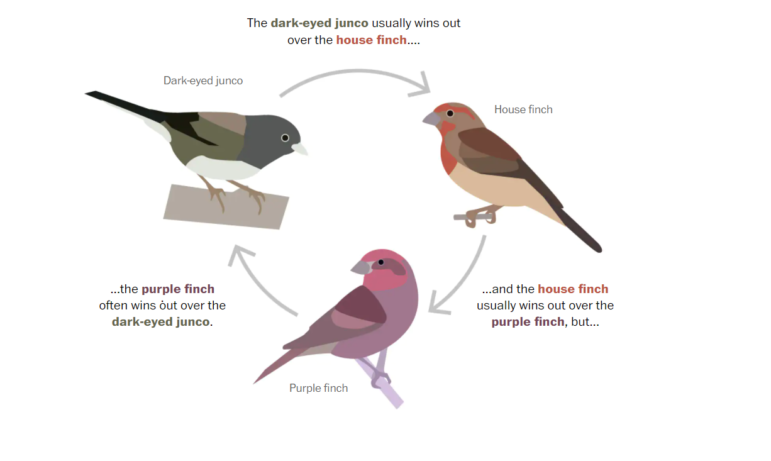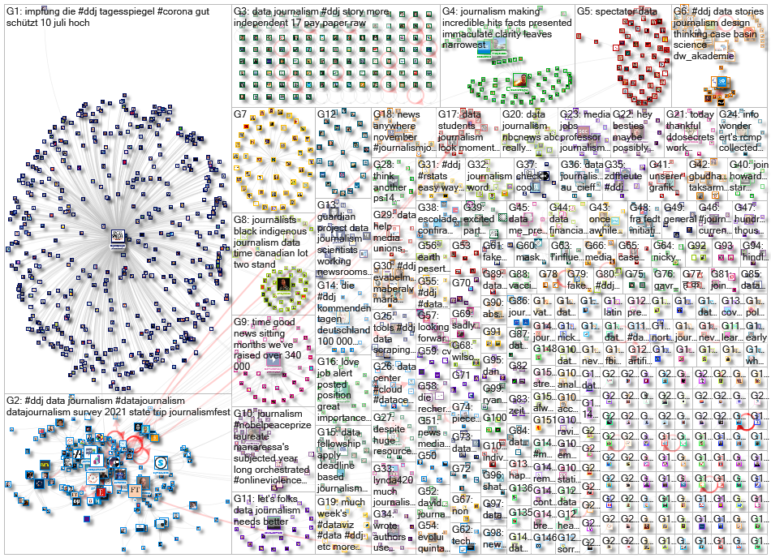
The Washington Post used data to answer the question: Which birds are the biggest jerks at the feeder? Image: Screenshot
The pandemic has changed the world in many ways. In America, lifestyle shifts set in motion by the COVID-19 outbreak have led people to relocate to other states to start new jobs or work remotely. Many have escaped the big city to find a new home in less populated areas. So, where is the best place to live based on your personality and needs? Our weekly analysis of the most popular data journalism stories on Twitter highlights a New York Times story aiming to answer that question. In this edition, we also feature an examination of the pecking order of birds based on their dominance at the feeder, an investigation into the problems of European rail, and a survey on the state of data journalism.
Bird Power
When it comes to bird feeders, there is a comprehensive, if hidden, hierarchy. The American crow is the most dominant species, according to a study based on a database of almost 100,000 bird interactions. The Washington Post illustrated the pecking order in the bird world in the northeastern part United States, revealing “the subtle rules of a hidden avian social order.”
I’ve been wanting to write up this study for years, and the wait paid off!
the brilliant @EliotITMillerd provide us with more than 10x the data used in the original study, making for the most robust and extensive bird ranking yet!
w @alyssafowers: https://t.co/cI8r9GhHCs pic.twitter.com/DBennnN4yP
— Andrew Van Dam (@andrewvandam) November 28, 2021
Germany’s Pandemic Toll
After nearly two years of the pandemic, Germany has now recorded 100,000 coronavirus deaths. The first victims of COVID-19 in the country are considered to be a 78-year-old from Heinsberg and an 89-year-old from Essen, according to a Der Spiegel analysis of how the virus swept through the country. The head of data visualization at Der Spiegel, Matthias Stahl, shared a thread visualizing the data from each death since March 2020.
And here's the full sequence from 2 to 100,000 deaths. pic.twitter.com/HtCxdNLfDi
— Dr. Matthias Stahl 🇪🇺 (@h_i_g_s_c_h) November 25, 2021
Fighting Big Tech
Three-and-a-half years after Europe introduced tougher online and data privacy rules, the General Data Protection Regulation (GDPR) is finally starting to have a significant impact. Since May 2018, 880 sanctions have been filed amounting to a total of €1.3 billion ($1.47 billion USD), according to an analysis by El Orden Mundial, a Spanish site.
📄💻 Tres años y medio y 880 multas después, la aplicación del GDPR llega por fin a las big tech.
746 millones de euros le han caído a Amazon en Luxemburgo y 225 a WhatsApp en Irlanda.
Un análisis de @elOrdenMundial para @EdjNet y @panelfit https://t.co/gSnRlRnUhK pic.twitter.com/Vc34KI9VPT
— Álvaro Merino (@Alvaro_Merino_) November 16, 2021
The Best Places to Live (for You)
Work and quality of life priorities have changed in the US as a result of the pandemic, and many people are looking for a new place to call home. The New York Times created this interactive tool offering data on the best places to live, using reader inputs such as political beliefs, preferred weather, school quality, crime rates, and affordability. According to this tool, the data helps explain why so many people are moving to Texas.
My @nytopinion colleagues created an amazing database to look for places to live. I used it to figure out why everyone’s moving to Texas.
Texas’ cities are affordable, full of jobs, racially and politically diverse, and Dallas faces lower climate risks https://t.co/d9rCpXWfAy
— farhad manjoo (@fmanjoo) November 23, 2021
Europe Derailed
The EU dubbed 2021 the European Year of Rail, as officials tried to promote one of the safest and most sustainable forms of travel. The initiative was meant to encourage countries to invest more in railway networks and divert their focus from roads. But a project by Investigate Europe and its media partners found this hasn’t happened. In fact, the outlet claims, the data show that Europe’s railways are in worse condition now than 20 years ago.
Our new #investigation is out! #Derailed 🛑 Europe's #railways are in a worse state than 20 years ago. EU states invest more in road. National railway companies seal off against international connections. Passengers don't have many rights. Read more 🛤️https://t.co/y5AWN2fw28
— Investigate Europe (@investigate_eu) November 19, 2021
Forestry Exports
An exclusive story by Brazil’s investigative nonprofit Agência Pública reveals new information about deforestation in the Amazon. According to the outlet, in the 15 months between February 2020 and May 2021, lumber exports from the Amazon exceeded the previous four years, and included thousands of tons of forest species considered threatened by the Brazilian Forest Service.
EXCLUSIVO. Nos 15 meses, entre fevereiro de 2020 e maio de 2021, em que um decreto do Ibama vigorou, as exportações de madeira da Amazônia superaram os quatro anos anteriores. Inclusive de espécies ameaçadas de extinção. https://t.co/U2ghH5D5yh pic.twitter.com/feqCglmJeQ
— Agência Pública (@agenciapublica) November 22, 2021
Fearmongering in Russia
In Russia, incidents involving migrants often become front page news, and critics say some of these stories are sensationalized and used to generate hostility towards newcomers. Two of Russia’s last independent newsrooms, IStories and Novaya Gazeta, joined forces to analyze popular Telegram channels of bloggers, journalists, state media, and news groups to examine who writes the most about migrants and how their coverage impacts public perception.
Правда ли мигранты настолько опасны, как о них говорят? Опровергаем мифы с помощью данныхhttps://t.co/70lwt80DGD pic.twitter.com/e9gLdc2ux6
— Важные истории (@istories_media) November 23, 2021
The Arab Cup
The World Cup, FIFA’s trademark football (soccer) competition, takes place next year in Qatar. This month, the country is hosting another sporting event, which brings together 16 teams from across the Arab world. The Arab Cup is a prelude to the upcoming global tournament and will mark the inauguration of new stadiums whose construction has been surrounded by a major controversy involving the deaths of migrant workers. To set the stage, Al Jazeera’s graphics team visualized all international soccer games played between countries in the region since 1957.
🎉NEW #dataviz #ddj with @haddadme @SebBillard_ @showkatshafi on @AJLabs @AJEnglish
It visualises all the international football match played between all the 23 Arab countries since 1957, in the context of #FIFAArabCup that will start on 30 Nov in #Qatarhttps://t.co/utnpE2Tud4 pic.twitter.com/JTn4967pcc
— Mohammed Hussein (@muhhossein) November 27, 2021
The State of Data Journalism
What are the biggest challenges facing data journalists? What is the state of data journalism where you are? What do you think about the future of the field? Our friends at DataJournalism.com are conducting a survey to get insights into the state of data-driven reporting and the technology newsrooms are using to produce outstanding projects. Join the survey and contribute with your feedback. By participating, you might win a trip to the 2022 International Journalism Festival in Perugia, Italy.
Our @datajournalism team is mapping the global state of #datajournalism & you can help!
Fill in this survey & share your insights about the field, the tools and technology used, and the direction in which data journalism is evolving.
👉 https://t.co/CaMSWWKoUh pic.twitter.com/MceAkcATOa— European Journalism Centre (@ejcnet) November 23, 2021
Sigma Awards
Entries are now open for the 2022 Sigma Awards, a global competition celebrating the best data journalism worldwide. Data reporters and teams can submit their applications by January 7th. Send your best work and compete for the $5,000 cash prizes, which will be split among the creators of the winning projects.
📢Hey, #datajournalism folks around the world, entries for the #Sigmas22 are now open! 🥳You have until 7 Jan 2022 to gather your best #ddj works from 2021 and head to our website https://t.co/3IFFANFyHw. 💸US$5,000 up for grabs. No Categories. The competition is ON.
— sigmaawards (@sigmaawards) November 26, 2021
Thanks again to Marc Smith and Harald Meier of Connected Action for gathering the links and graphing them. The Top Ten #ddj list is curated weekly.
 Peter Georgiev is GIJN’s social media and engagement editor. Previously, he was part of NBC News’ investigative unit in New York. He also worked as a correspondent for Bulgarian National Television and his reporting has been published by the Guardian, Deutsche Welle, and other international outlets.
Peter Georgiev is GIJN’s social media and engagement editor. Previously, he was part of NBC News’ investigative unit in New York. He also worked as a correspondent for Bulgarian National Television and his reporting has been published by the Guardian, Deutsche Welle, and other international outlets.

